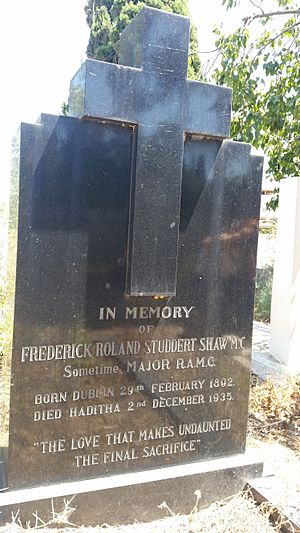Frederick Shaw (cricketer) facts for kids

Shaw's resting place at Haifa Cemetery
|
|||||||||||||||||||||||||||
| Personal information | |||||||||||||||||||||||||||
|---|---|---|---|---|---|---|---|---|---|---|---|---|---|---|---|---|---|---|---|---|---|---|---|---|---|---|---|
| Full name |
Frederick Roland Studdert Shaw
|
||||||||||||||||||||||||||
| Born | 29 February 1892 Dublin, Ireland |
||||||||||||||||||||||||||
| Died | 2 December 1935 (aged 43) Haditha, Iraq |
||||||||||||||||||||||||||
| Batting | Right-handed | ||||||||||||||||||||||||||
| Bowling | Right-arm fast-medium | ||||||||||||||||||||||||||
| Domestic team information | |||||||||||||||||||||||||||
| Years | Team | ||||||||||||||||||||||||||
| 1922/23 | Europeans (India) | ||||||||||||||||||||||||||
| 1913–1914 | Ireland | ||||||||||||||||||||||||||
| Career statistics | |||||||||||||||||||||||||||
|
|||||||||||||||||||||||||||
|
Source: Cricinfo, 5 November 2018
|
|||||||||||||||||||||||||||
Frederick Roland Studdert Shaw (born February 29, 1892 – died December 2, 1935) was an Irish cricket player and a British Army officer. He played "first-class" cricket, which is the highest level of the sport. He was also honored with the Military Cross for his bravery in the army.
Contents
Early Life and Cricket Beginnings
Frederick Shaw was born in Dublin, Ireland, in February 1892. He went to school in England at Archbishop Holgate's School. After finishing school, he returned to Dublin in 1909. There, he studied medicine at Trinity College.
While studying, he played club cricket for Dublin University Cricket Club. He made his first big cricket appearance for Ireland in 1912. This match was against Scotland in Edinburgh. He played against Scotland again in 1914 in Dublin. In that game, he scored 65 runs in Ireland's first turn at bat.
Serving in World War I
Frederick graduated from Trinity College in 1914. Soon after, he joined the British Army to serve in World War I. He became a lieutenant in the Royal Army Medical Corps in August 1914. This group provides medical care for soldiers.
He was promoted to captain in January 1916. For his brave actions, he received the Military Cross in January 1917. By the end of the war, he was an acting major. He later returned to his captain rank in June 1919.
Cricket and Army Life After the War
After World War I, Frederick continued his service in the British Army. He was sent to British India. There, he played first-class cricket for the Europeans in a tournament in 1922–23. He played two matches against other teams, the Hindus and the Muslims.
While in India, he helped lead a group of ambulance vehicles. He also assisted during a serious illness outbreak in an area called Waziristan. He worked with the Director of Medical Services in India.
When the Irish Free State was formed in 1922, Frederick returned to the United Kingdom. He played three more first-class cricket matches for the British Army cricket team. One game was at Lord's in 1923 against the Royal Navy. He played two more matches in 1925 against university teams.
Frederick Shaw's Cricket Stats
In total, Frederick Shaw played seven first-class cricket matches.
- He scored 193 runs, with his highest score being 65 runs.
- He was a "fast-medium bowler," meaning he threw the ball quickly.
- He took 21 wickets, which means he got 21 opposing batters out.
- In one important match, he took 14 wickets in total. This was in the final of the Lahore Tournament.
Later Life and Work
Around 1925, Frederick was sent to Iraq with the army. In 1926, during a local uprising, he helped free two Royal Air Force officers who had been captured.
Soon after, he left the army. In October 1927, he joined the Iraq Petroleum Company as their Chief Medical Officer. He passed away in Iraq in December 1935, at a pipeline station near Haditha. He is buried in the Haifa Cemetery in Israel. Interestingly, he was a cousin of the famous writer George Bernard Shaw.

